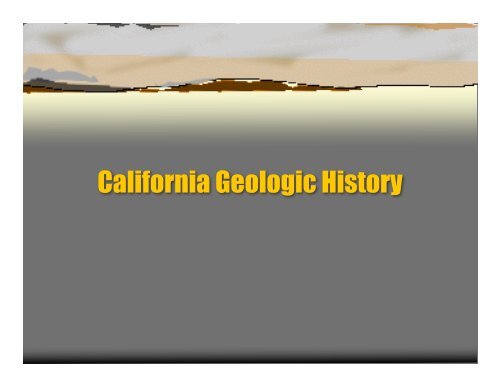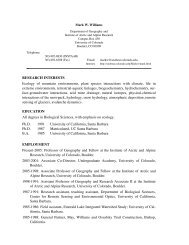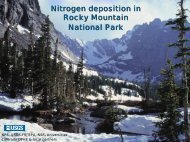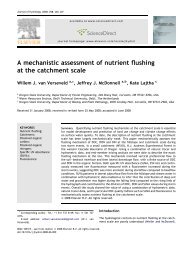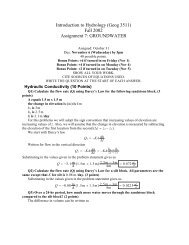California Geologic History
California Geologic History
California Geologic History
- No tags were found...
Create successful ePaper yourself
Turn your PDF publications into a flip-book with our unique Google optimized e-Paper software.
<strong>California</strong> <strong>Geologic</strong> <strong>History</strong>
Why do Sierra Nevada look this way?
Alabama Hills
Proterozoic and Paleozoic Era(2,500-245 mya) Rocks older than 600 million years are rare in<strong>California</strong>. The oldest rocks, which are more than 1,000 millionyears old, are located in the eastern deserts and theeastern Transverse Ranges (San Bernardino and SanGabriel Mountains). The distribution of rocks of these ages suggests that thewest coast of the North American Continent was well tothe east of all but the southern end of what is now<strong>California</strong>.
Proterozoic and Paleozoic Era All of these very old formations have been extensivelymetamorphosed-difficult to determine the conditionsthat existed when they were originally formed. Some of the oldest (around 1,800 million years old) arelocated in the mountains around Death Valley and aremuch like the rocks exposed in the inner gorge of theGrand Canyon. Metamorphic rocks around 1,000 million years old in theSan Gabriel Mountains and the Orocopia Mountainseast of the Salton Sea.
Proterozoic and Paleozoic Era 1,000 million years ago and 400 million years agoappears to have been quiet in western North America. The coastline remained east of <strong>California</strong>, probably inUtah and Idaho. Very thick sections of marinesedimentary rocks from this period are exposed in themountains east of the Sierra Nevada. For the most part,these rocks are carbonates (limestone and dolomite),indicating shallow, warm ocean conditions with littleincoming terrestrial sediment—possibly similar to theGulf of Mexico today.
Antler and Sonoma Events Around 400 million years ago the quiescent period inwestern North America came to an end.Antler Orogeny-Development of an offshore island arc. Theevidence for this event is strongest farther east, but there areindications in the northern Sierra Nevada and Klamathregions. Possibly similar to Japan today.Sonoma Orogeny-250 mya-This event is most evident incentral Nevada, which may have been the location of thecoast at the time. The orogeny seems to have marked thejoining of the island arc containing rocks now found in theSierra Nevada foothills and central Klamath Mountains withthe rest of the continent. This event appears to mark the firsttime the coast moved west into most of <strong>California</strong>.
Mesozoic Era (245-65 millionyears ago) Nevadan Orogeny – 210 mya. Uplift of theancestrial Nevadan Mountains caused by theformation of the main body of intrusive graniticrocks that now make up most of the SierraNevada (subduction zone probably similar to thecurrent situation along the West Coast of SouthAmerica).
Mesozoic Era 245-65 mya By 150 million years ago the Nevadan Mountainscomposed the western coast of North America and thesea never again extended farther east than the easternedge of what is now the Central Valley. At roughly the same time the granitic rocks wereforming that are now found in the Peninsular Range ofSouthern <strong>California</strong> and in the Salinian block that runsalong the western edge of the San Andreas Fault in thecentral and southern Coast Ranges.
Cretaceous Forces that created the intrusive granitic rocks ofthe Sierra Nevada and Southern <strong>California</strong>continued episodically until about 90-100 millionyears ago. During the same period sedimentarydeposits were accumulating on the continentalshelf, slope, and in an offshore subduction zone.
Cretaceous By that time the subduction zone had shifted west toabout the current location of the Coast Ranges Deposits in the subduction zone were mixed with rocksfrom the upper mantle beneath the crust producing theFranciscan Formation (extends from northern SantaBarbara to the northern <strong>California</strong> coast). The oceanic crustal material in the Franciscan formationwas thrust up against the Sierran block by about 75million years ago, extending the boundary of the NorthAmerican plate further west.
Cenozoic By about 50 million years ago the ancestral NevadanMountains had eroded down to relatively low-lying hills. Large rivers flowed through the region and depositedgravels rich in gold. The southern Sierra Nevada and Mojave region wereelevated enough to allow for the erosion and depositionof thick layers of marine sedimentary rocks in what arenow the southern Coast Ranges and westernTransverse Ranges.
Cenozoic This deposition continued without interruptionuntil around 40 million years ago. Over the next10 million years the coast shifted back and forth,producing a patchwork of marine and nonmarinesedimentary rocks in the Coast Rangesand western Transverse Ranges.
Cenozoic 25-29 million years ago. The oceanic plate that hadbeen subducting beneath the western edge of NorthAmerica became completely overridden, starting in thesouth, and the North American and Pacific plates cameinto direct contact for the first time. Tangential motion and expansion replaced convergentmotion as the North American plate began interactingwith the Pacific plate. The San Andreas Fault system was formed. In far northern <strong>California</strong> and the Pacific Northwest,north of the Mendocino triple junction, convergentmotion has continued right up to present times.
Cenozoic Volcanic activity, related to extension and thinning of the crust,became widespread in the Sierra Nevada and Mojave regionsaround 20 mya. Around 10-15 mya a series of deep marine basins formed alongthe coast between Orange County and the San Francisco region.The appearance of the basins may have signaled the passage ofwhat is now coastal southern and central <strong>California</strong> over thespreading zone. The rocks formed in these basins (Monterey Formation) arecomposed mainly of material derived from marine organisms,rather than terrestrial sediments.
Cenozoic About 5 million years ago mountain-building activity rapidlyaccelerated, and finally most of the modern mountain rangeswere uplifted, including the Sierra Nevada and the large faultblockranges to the east, the Coast Ranges, the TransverseRanges, and the Peninsular Ranges. San Andreas Fault jumpsinland. Subduction continued in the north forming the major volcanoes ofthe Cascades. Pleistocene glaciation in the Sierra Nevada and, to a minorextent, in the San Bernardino Mountains; recent volcaniceruptions in the Mojave and Great Basin regions; and thewidespread volcanic activity that created the southern Cascadevolcanoes (Mt. Shasta and Mt. Lassen) and the lava flows of theModoc Plateau region.
The big knot:KillerEarthquakesIn the future!
SUMMARY Accreted terranes Nevadan orogeny Farallon plate San Andreas Fault Present uplift


